SOY
PASTE » QUALITY
MORE ON THE QUALITY OF TEKMASH® SOY PROCESSING TECHNOLOGY
| TECHNOLOGY
FACTOR
|
ōSOY COWö STANDARD
|
IR ¢ infrared thermal processing |
EXTRUDER |
Chemical and mechanical
processing |
TEKMASH® |
| 1. Economy |
•• |
••• |
••• |
••• |
••• |
| 2. Energy |
•• |
• |
• |
••• |
••• |
| 3. Environment |
•• |
• |
• |
• |
••• |
| 4. Product quality*)
|
•• |
• |
• |
• |
••• |
| 5. Depth of raw material processing |
•• |
• |
••• |
••• |
••• |
| Appendix 1 |
ōWetö method |
ōDryö method |
ōDryö method |
ōDryö method |
ōWetö method |
| Appendix 2 /End products/ |
Soy milk, soy milk
sediment |
ŽŅļĒŅµĶĒÓ ņ¾ĻÓ,
ŅÕ°ĻĶ
|
Soybean oil, SOYCAKE |
Fat-free flour, isolate,
concentrate |
Paste, creamy product
with full fat content |
|
• -
DOWNGRADED
•• -
STANDARD
••• -
UPGRADED
|

*)
End product quality is defined, above all,
by its safety, nutritive value and assimilability in the organism.
Of course, any technology can be analyzed from various perspectives,
e.g. considering its economy and energy consumption factors,
end product quality, depth of raw material processing, etc.
It is widely known, that simultaneous improvement of all these
factors is virtually impossible.
Thus, if we buy the same product in a developed country and
in an economically challenged one, the reality is that we
get two totally different products, varying both in price
and in quality. Naturally, the lower the quality, the cheaper
the product...
It is not a secret that this is the reason why hazardous
production is moved away from developed countries to third
world nations. Thus, the economy of these developing countries
improves and the price for that is environment pollution.
The price for the high quality of soy milk produced by ōsoy
cowsö is high energy consumption. A long series of similar
examples has one thing in common: where one of the factors
is improved, this happens at the expense of all the others.
If we were to draw a diagram of the four main characteristics
of any production technology (regardless of their quantitative
values), we would present the classic technology with equal
circle segments, according to the established tradition.
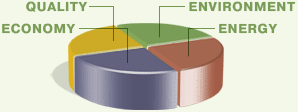
Here is a possible option of this technology, where the
cost is reduced (or the economy factor is improved) at the
expense of downgrading all other factors (energy consumption,
environment, quality).
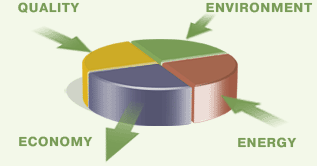
The diagram below represents improving energy and economy
factors at the expense of downgrading the environment factor
and the product quality.
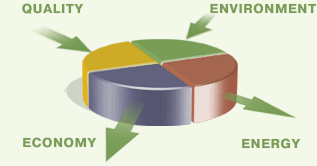
Analyzing existing soy processing technologies from this
perspective, with the introduction of another factor, the
depth of processing, one can visualize the quality and advantages
of the suggested processing method. For this purpose, let
us take as a standard the processing technology
utilized by ōsow cowsö of Chinese or Canadian design.
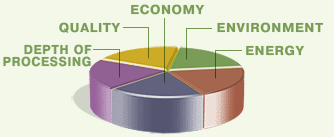
Under this technology, soy beans are rinsed and soaked in
water (usually the water is changed several times). After
this they are ground, mixed with water and heated by steam
to near-boiling temperature. Quality soy milk and sediment
is obtained as a result of this process. These food products
are popular all over the world, and equipment units named
ōsoy cowsö are also widely spread.
The process of soy milk production is characterized by high
energy consumption (around 1.14 kW*hour per 1 lb of soy beans).
The depth of processing in this case reaches 80...90%, mainly
due to washing of water-soluble content of proteins, starch
and sugars (a number of soy milk production technologies use
additional preliminary beans shelling). The high content of
organic substances in waste waters of the processing enterprises
causes significant environment pollution. That is why expensive
water treatment is mandatory.
The presently popular infrared (IR) method of soy seeds processing
with further grinding in colloidal mill is characterized by
a relatively low electric energy consumption rate (0.32-0.45
kW*hour per 1 lb of soy beans) and relatively high savings
factor at the expense of quality loss of the end product caused
by partial burning and caramelization of carbohydrates, fats
and, especially sugars, which leads to formation of hazardous
products of thermal oxidization.
In this case the depth of processing reaches 85...90% due
to partial loss of the product.
The process of soy milk production is characterized by high
energy consumption (around 1.14 kW*hour per 1 lb of soy beans).
The depth of processing in this case reaches 80...90%, mainly
due to washing of water-soluble content of proteins, starch
and sugars (a number of soy milk production technologies use
additional preliminary beans shelling). The high content of
organic substances in waste waters of the processing enterprises
causes significant environment pollution. That is why expensive
water treatment is mandatory.
The presently popular infrared (IR) method of soy seeds
processing with further grinding in colloidal mill is characterized
by a relatively low electric energy consumption rate (0.32-0.45
kW*hour per 1 lb of soy beans) and relatively high savings
factor at the expense of quality loss of the end product caused
by partial burning and caramelization of carbohydrates, fats
and, especially sugars, which leads to formation of hazardous
products of thermal oxidization.
In this case the depth of processing reaches 85...90% due
to partial loss of the product.
For better visualization, the specified tendencies of economy
and energy factors improvement at the expense of the downgrading
of the other three ones, which is peculiar for IR processing
method, are illustrated in the following diagram.
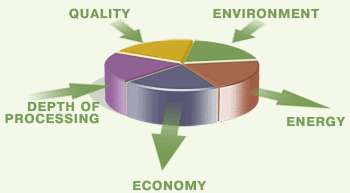
The most widely spread soy processing technology used all
over the world is implemented through high pressure created
by the extruder in the processed medium. The soy beans temperature
exceeds 212░F (100░C), which leads to neutralization of several
harmful compounds contained in soy. However, at the same time,
a greater part of fats is lost due to high pressure, and the
obtained soy cake loses vitamins. Moreover, exposed to air,
it also quickly loses unique polyunsaturated fatty acids.
Here we have a very economic process due to low energy consumption
and no environment pollution alongside with a significant
quality loss of the end product.
The specified growth and decline tendencies of the processing
technology characteristics are illustrated by the diagram
below.
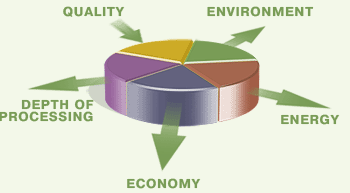
The industrial technology for soy flour production (obtained
by dehydration and isolation) is used for food purposes. In
this case oil is preliminary extracted from soy beans. The
oil is extracted by hexane, a hazardous chemical compound,
which traces can be found in the end product. Of course, this
process cannot be referred to environment friendly ones, however,
at high production volumes, considering the value of the end
product - fat-free dry powder, concentrate or isolate, it
can be considered highly profitable.
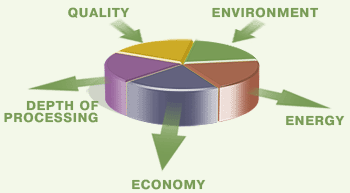
It should be mentioned that the so called "dry"
processing technologies, where no water is used, clearly have
the tendency of a poorer quality of the end product and a
better energy consumption rate (i.e. a higher economy factor)
comparing to the ōwetö technology, for example the one using
a ōsoy cowö.
This situation can easily be explained, taking into consideration
the fact that soy beans contain a number of biologically and
chemically active compounds, which are immediately oxidized
in the air by oxygen (the soy grade is determined by the number
of broken beans). A broken bean shell causes fast oxidization
and fats rancidity.
At the same time, we need to point out that the ōwetö soy
beans processing technology has the energy factor disadvantage
due to high thermal capacity of the heated liquid and low
concentration of soy beans.
This discrepancy prompts the idea of combining the advantages
of the ōwetö and the ōdryö processing technologies. Thus,
a highly concentrated mixture of soy and water can be processed
in a hydro module with no exposure to the outside air. In
this sense, TEKMASH® hydrodynamic processing
technology can be viewed as a certain compromise, combining
the advantages of the ōwetö and the ōdryö technologies.
TEKMASH® technology is characterized by a relatively low
energy consumption (0.23-0.27 kW*hour per 1 lb of soy beans),
absolutely no environment pollution, 100% processing depth
and retaining almost 100% of all nutritive components contained
in natural soy, which together with the simplicity of the
technical implementation leads to high economy factor of the
suggested technology. The tendency of improvement of all the
factors:
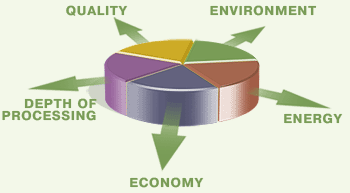
The above mentioned arguments give grounds to believe
that the simultaneous improvement of all specified characteristics
in TEKMASH® processing technology has the world-wide
novelty confirmed by a number of international patent applications.
Printer
Version |